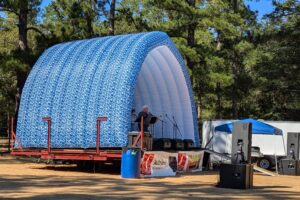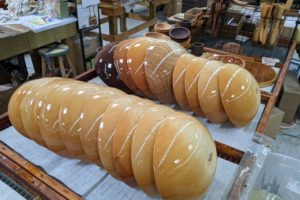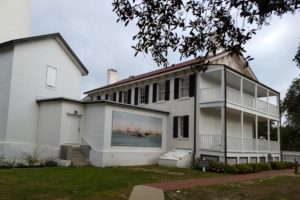While the draw of this park is the manatees that swim in a cove during the winter, the area also has an amazing history starting in the mid-1800s that I think you’d like to know about. As we’ve learned on previous trips, civilization always starts along the waterways.
3000 years ago
The 1st settlers left behind signs of their activities in their “dumps,” which were made up primarily of millions of shells. The archeologist Jeffries Wyman concluded that the mounds built here were left by those living here 3000-4000 years previously. The largest mound is where the Thursby house was built. The second largest mound may have originally been part of the other mound but had been separated by the spring outflow.
Wyman wrote that the human bones had been punctured in the same ways as the bones of deer, opossum, turtle, and alligator. His conclusion was that these “perforations” were the result of the practice of cannibalism by the native residents of the area.
I wonder what our dumps will say about us.
1766 – William Bartram was a famous naturalist, artist, and poetic writer who first visited the area in January 1766. His writing and artwork inspired such naturalist artists as John James Audubon and Romantic poet Samuel Taylor Coleridge. What he saw was really different from our view today.
“This creek, which is formed instantly by this admirable fountain, is wide and deep enough for a sloop to sail up into the basin. The water is perfectly diaphanous [light, delicate, translucent], and here are continually a prodigious number and variety of fish; they appear as plain as though lying on a table before your eyes, although many feet deep in the water. . . .A pale bluish or pearl colored coagulum [information following] covers every inanimate substance that lies in the water, as logs, limbs of trees. Alligators and gar were numerous in the basin.”

The nutrient content today includes nitrogen and phosphorous from such human sources as septic use and lawn fertilization.
1842 – The Second Seminole War between the U.S. and the Seminole Indians ended in 1842 when the Indians were sent to Oklahoma or forced into the Everglades. The end of this war opened up the interior of Florida to the white man.


Here’s some information about this river from AI: “The St. Johns River is special because it’s Florida’s longest river at 310 miles, and it’s one of the few rivers in the US that flows northward [toward the Atlantic Ocean]. It also has a very slow gradient, making it one of the “laziest” rivers in the world. The river is also a significant part of Florida’s history, culture, and economy, playing a role in transportation, recreation, and supporting various ecosystems.”

1870 – In this year, archaeologist Jeffries Wyman was helped by the Thursby family in locating a multitude of mounds with an abundance of cultural artifacts. More surveys were done in the 1890s.


1765 – written account of these waters
The British Crown recognized the work of a botanist in colonial Pennsylvania, John Bartram, and appointed him as the Naturalist for Florida in 1765. He set out to find the source of the St. Johns River. While exploring the upper reaches of this stream, John and his son William came upon a “surprising fountain” that is now called a boil that keeps the water in the cove at a steady temperature. This temperature is what the manatees love during the cold months. Bartram was the first to leave a written account of the natural scenery at Blue Spring.

If you want to see this boil and the manatees we saw in 2019, you may want to see this post from when we were here in 2019.
1865 – Civil War
The hardship of this war reached St. Johns River when some Union gunboats invaded the waterways. While the river wasn’t a major battleground, it was an important supply one for Confederate troops. Steamboats were seized, cutting off the delivery of mail and outside goods. The greatest disruption was the breakup of families. Louis Thursby, like other settlers, was captured and imprisoned as a southern sympathizer.

The end of the Civil War in 1865 meant a return to everyday life on the river. Families were reunited and steamship service resumed. The growth of the St. Johns region could be seen in the changes at Blue Spring.

1868 to 1880s – great steamboat era
By this year, the Thursbys had built the Landing, and Blue Spring became a regular-posted stop between Jacksonville and Enterprise. The Landing had a covered storage barn, a pagoda to shelter passengers from summer heat and winter winds, and an open dock area.

During the 1880s, five steamboats a day were running, and many stopped at Blue Spring for both freight and tourists. When the US mail began arriving daily, Mary Ann acted as postmistress while Lewis was responsible for freight and passengers.
1881 – the railroad
During this year a narrow gauge railroad was laid from Orange City to Blue Spring (only 2 miles away). The primitive railway was mule-drawn and linked groves in Orange City to the Landing. It also transported the Thursby family and boat passengers into Orange City.



1894 to 1895 – the big freeze
In February the Thursbys and other local growers sent large amounts of fruit to the packing house. The crew had been busier than ever crating up oranges for northern shipment.

But the groves in town and at Blue Spring were killed to the ground by a hard freeze.

With the decline of river traffic and the freeze damage in 1895, the use of land changed around Blue Spring.

1972
This was the year that the Florida Park Service bought Blue Spring for our benefit.

Now that we’ve seen the development and growth in this part of interior Florida, let’s look closely at the Thursby family.





Leave a Reply
Your email is safe with us.